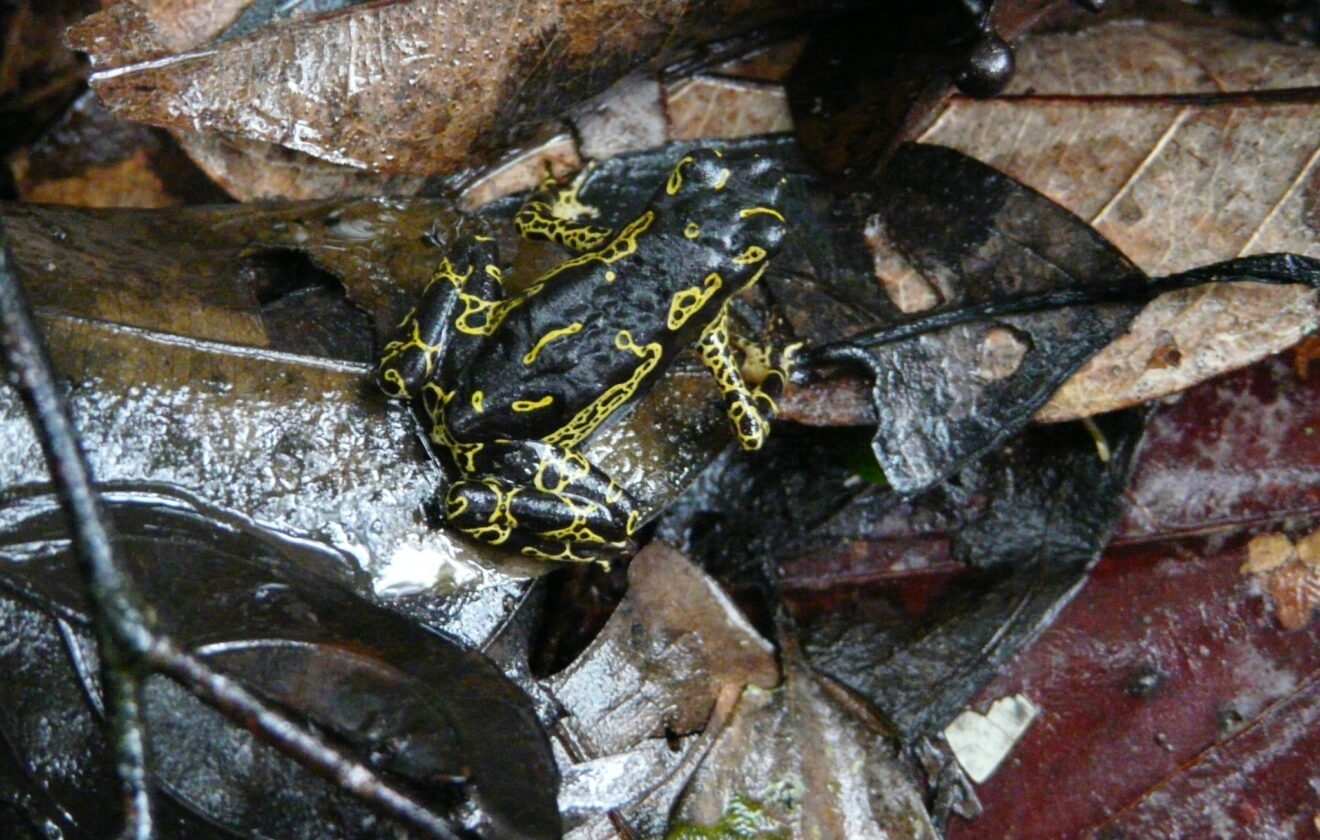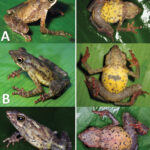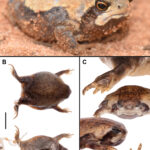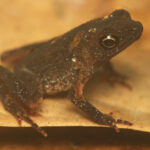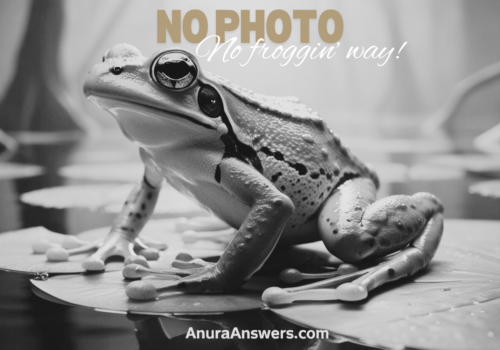- Discovering Atelopus hoogmoedi: The Hidden Jewel of the Amazon Rainforest
- Taxonomy and Classification: Understanding Atelopus hoogmoedi
- A Home Beneath the Canopy: Natural Habitat of Atelopus hoogmoedi
- A Visual Symphony: Physical Characteristics of Atelopus hoogmoedi
- Behavior and Life Cycle: The Secret Lives of Atelopus hoogmoedi
- Ecological Importance: Guardians of Ecosystem Balance
- Conservation Status and Challenges: Protecting a Fragile Jewel
- Cultural and Scientific Significance: Beyond Biology
- Conclusion: Inspiring Conservation through a Tiny Jewel
Discovering Atelopus hoogmoedi: The Hidden Jewel of the Amazon Rainforest#
In the lush, primeval jungles of the Amazon Basin, among emerald leaves glistening with raindrops and dense carpets of moss covering age-old tree trunks, quietly dwells a small amphibian both charismatic and mysterious—the Hoogmoed Harlequin Frog (Atelopus hoogmoedi). Within the intricate tapestry of tropical wildlife, this vividly colored toad offers a fascinating story of adaptation, survival, and ecological importance.
Officially classified as Atelopus hoogmoedi, named in honor of Dutch herpetologist Marinus Steven Hoogmoed, this extraordinary species gracefully wears bold patterns in striking yellow and black hues, serving both as a warning to would-be predators and as a dazzling adornment amid the jungle’s shadows. Yet despite its radiant appearance, this miniature marvel often goes unnoticed, quietly playing its integral role throughout the Amazon ecosystem.
Today, let us embark on a journey deep into the heart of the rainforest to explore the remarkable life, ecology, threats, and conservation of Atelopus hoogmoedi, shedding light on this ecological gem hidden within the green embrace of the world’s most biodiverse landscapes.
Taxonomy and Classification: Understanding Atelopus hoogmoedi#
Atelopus hoogmoedi belongs to the Bufonidae family, commonly known as true toads. Within this expansive family, the impressive Atelopus genus, encompassing harlequin toads, captivates biologists and naturalists due to their vibrant coloration and perplexing behaviors. Identified and officially named by Lescure in 1974, Atelopus hoogmoedi finds close kinship with various other species of harlequin frogs spread throughout South and Central America.
The genus Atelopus itself is widely recognized for its astonishing array of striking colors and patterns, serving as brilliant examples of aposematism—warning coloration signaling their inherent toxicity. Closely related species, such as Atelopus zeteki (Panamanian golden frog) and Atelopus varius, share similar biological traits: brilliantly adorned with powerful toxins secreted through their skin as effective defense mechanisms against predators.
A Home Beneath the Canopy: Natural Habitat of Atelopus hoogmoedi#
The Hoogmoed Harlequin Frog thrives within the verdant, shadowed realms of the lower Amazon Basin, predominantly in Suriname, Guyana, French Guiana, and nearby portions of northern Brazil. Here, scattered across regions marked by crystal-clear streams, damp leaf litter, and dense organic decay, the species has carved out a unique ecological niche amid seemingly chaotic biological diversity.
A perfect habitat for Atelopus hoogmoedi features pristine freshwater streams flowing gently beneath towering trees—almost cathedral-like formations adorned with mosses, lichens, and aerial roots dripping moisture. These softly murmuring streams and their leaf-laden banks create critical microhabitats where frogs hunt, breed, and seek shelter.
An Intimate Relationship with Water#
Remarkably sensitive to habitat variation and fluctuations, Atelopus hoogmoedi maintains a profoundly intimate relationship with freshwater ecosystems. Clear, oxygen-rich streams are indispensable not only for hydration but also to facilitate their reproductive cycles. Females deposit gelatinous clusters of eggs beneath submerged rocks or among quiet pools within stream beds, ensuring their offspring have immediate access to necessary resources once hatched.
Preserving these delicate habitats becomes not merely conservation for a single frog species but an act that safeguards entire ecological communities, protecting everything from microscopic algae and aquatic insects to predatory birds and mammals dependent on these highly specialized environments.
A Visual Symphony: Physical Characteristics of Atelopus hoogmoedi#
Perhaps the most immediately captivating feature of Atelopus hoogmoedi is its striking appearance, vividly colored in bold hues of deep, glossy black interspersed dramatically with dazzling yellow or golden-orange markings. Each individual toad carries its unique pattern, much like human fingerprints, reflecting subtle yet perceptible variations that researchers use in identification and conservation work.
Small and delicate in stature—typically reaching lengths between approximately 2 to 3 centimeters—these frogs might seem fragile at first glance. Yet their petite bodies offer remarkable adaptations to jungle survival. Slender limbs assist them in careful navigation through dense understory vegetation, and sticky toe pads help facilitate climbing and finding purchase amid slippery vegetation or rocks near streams.
Aposematic Coloration: A Warning Sign#
The unforgettable visual display of Atelopus hoogmoedi is no frivolous beauty contest—rather, it acts as nature’s unmistakable warning sign. Underneath the vibrant exterior lies a potent cocktail of alkaloid toxins, synthesizing alkaloids from prey items and fungi they consume. Predators quickly learn to associate vibrant colors with unpleasant, potentially deadly experiences. As a result, even experienced rainforest hunters like birds and snakes generally avoid tangling with this visually dramatic but chemically formidable amphibian.
Behavior and Life Cycle: The Secret Lives of Atelopus hoogmoedi#
Like most amphibians, the life of this species follows the elegant rhythm of seasonal shifts and forest cycles. But beyond typical frog behaviors lies a world of unique and intriguing actions that set apart Atelopus hoogmoedi.
This species is primarily diurnal, distinguishing it from many other frogs active predominantly at night, spending daylight hours carefully hunting small invertebrates among leaf litter. Tiny ants, beetles, termites, and other insects provide nourishment, their chemical defenses absorbed and converted into protective toxins by the frog’s specialized biology.
A Delicate Courtship by the Streamside#
Breeding activity surges during the rainy seasons, where male Hoogmoed Harlequin Frogs embark on leaf and rock perches prominently positioned over and around stream edges, advertising their presence with a subtle series of chirping calls attuned specifically to attract females. Rival males may display competitive behaviors, wrestling for prime breeding spots, ensuring only the fittest finally succeed.
The delicate sequence culminates in amplexus, during which a persistent male embraces the female, fertilizing eggs externally as she releases them into quiet pools. Tadpoles develop rapidly in these protected aquatic niches, eventually emerging onto land as miniature yet fully functional adults prepared to brave jungle life independently.
Ecological Importance: Guardians of Ecosystem Balance#
Despite their humble size and quiet lifestyles, Atelopus hoogmoedi frogs contribute significantly to rainforest health, performing numerous ecological functions. As both predator and prey, their presence helps balance insect populations, benefiting plant life and indirectly even regulating disease-carrying insect populations.
Additionally, these frogs serve as vital indicators for environmental monitoring efforts: thriving populations signal pristine ecological conditions, while declining numbers may warn of broader environmental degradation, fulfilling an essential ecological role as “canaries in the coal mine” for biologists and conservationists worldwide.
Conservation Status and Challenges: Protecting a Fragile Jewel#
Sadly, the habitats that sustain these magnificent amphibians face severe threats, including habitat loss driven by logging, agriculture expansion, mining, and pollution. Climate change further disrupts delicate ecological balances, upsetting rainfall patterns essential for the survival of harlequin frogs.
Currently classified as Vulnerable on the IUCN Red List, Atelopus hoogmoedi populations continue declining rapidly in the wild, paralleling broader international concern for global amphibian decline. Captive breeding, habitat restoration, education, and monitoring initiatives form essential strategies in protecting these delicate creatures for future generations.
Cultural and Scientific Significance: Beyond Biology#
Among indigenous communities throughout the Amazon, the vividly colored Atelopus hoogmoedi often stands apart symbolically—sometimes representing caution, transformation, or even a guardian to spiritual realms. Moreover, scientists closely study their unique alkaloid toxins, exploring pharmaceutical potentials and uncovering chemical secrets that advance human medicine and scientific knowledge profoundly.
Conclusion: Inspiring Conservation through a Tiny Jewel#
From scientific intrigue and ecological essentiality to cultural symbolism, the Hoogmoed Harlequin Frog exemplifies the interconnectedness of life within the heart of the Amazon rainforest. Recognizing their worth compels us to support conservation efforts, preserve critical habitats, and advocate strongly for wildlife stewardship.
Together, by sharing awareness and supporting conservation strategies, we can protect Atelopus hoogmoedi—conserving its glorious secretive existence and pioneering our efforts to protect biodiversity across this thriving yet threatened, wildlife-rich paradise.








